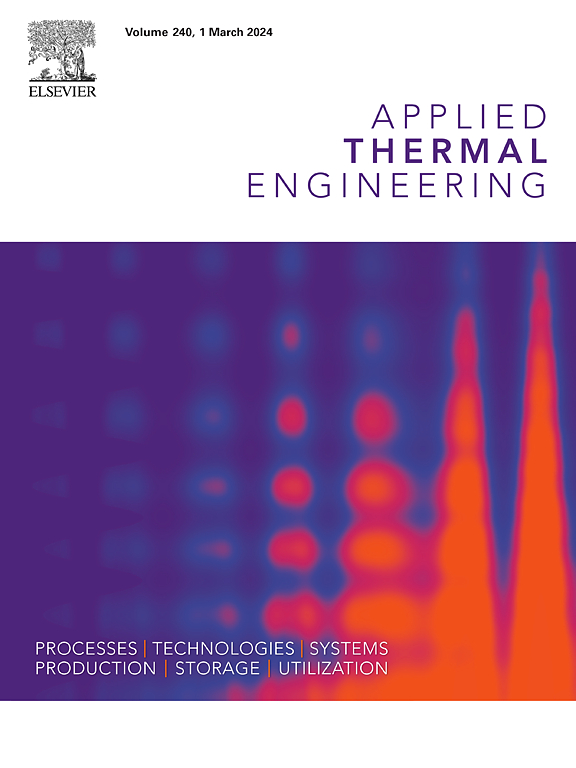工业供热网络中的高温热泵:能源使用、排放和经济性研究
IF 6.1
2区 工程技术
Q2 ENERGY & FUELS
引用次数: 0
摘要
工业用热在全球一次能源使用中占很大比重,主要依靠化石燃料燃烧。回收工业余热是减少总体能源消耗的一种方法。然而,不同工业场所的余热温度和数量差异很大。有些地方可能有大量温度相对较高的余热,而有些地方则可能没有任何余热。此外,对于大多数工业而言,可用余热的温度低于 100 °C,而热需求的温度较高。因此,利用高温热泵集成技术,通过工业供热网络将这些工业集中起来,可以提供一个很有前景的解决方案。然而,文献中缺乏对这一概念在能源使用、排放和经济方面的研究。不过,本研究从能源使用、碳排放和财务评估方面对三种不同的热网配置进行了区分和比较。这些配置包括 "以消费者为基础的热能升级网络"、"以供应商为基础的热能升级网络 "和 "以供应商为基础并附加热水网络的热能升级网络"。为此,利用第一和第二定律原理以及性能和成本方面的经验数据,开发了一种通用方法。该方法适用于从比利时根特北海港的十家公司收集的数据。结果表明,第一种配置的能源利用效率最高,因此碳排放量也最低。此外,它的热量平准化成本也最低。根据热泵的最高供应温度,与天然气锅炉相比,该配置可减少 70% 至 80% 的碳排放量。考虑到天然气价格较低,在不征收碳税的情况下,很难进行积极的财务评估。另一方面,2021-2022 年能源危机期间的一项评估表明,即使不征收碳税,在热泵最高温度为 160 °C 的情况下,与燃气锅炉相比,供热的平准化成本也会降低 19%。研究还发现,在能源价格动态变化的情况下,基于用户的热能升级网络和天然气锅炉的混合配置与单独的解决方案相比,可降低 LCOH,与最佳的单独解决方案相比,可降低 7.6%。这是通过在每个时间段内启用运行成本最低的技术来实现的。本文章由计算机程序翻译,如有差异,请以英文原文为准。
High-temperature heat pumps in industrial heating networks: A study on energy use, emissions, and economics
Industrial heat significantly contributes to global primary energy use and primarily relies on fossil-fuel combustion. Recovering residual heat in the industry offers a means to reduce overall energy use. However, the temperature and amount of residual heat available varies widely across industrial sites. Some may have a large amount of residual heat available at relatively high temperatures, while others may not have any residual heat available. Furthermore, for most industries, the residual heat available is at temperatures below 100 °C, while the heat demands are at higher temperatures. Hence, clustering these industries by industrial heating networks, using high-temperature heat pump integration, could offer a promising solution. Research on this concept regarding energy use, emissions and economics is however lacking in the literature. This study however distinguishes and subsequently compares three different heat network configurations in terms of their energy use, carbon emissions and financial appraisal. These configurations include a ‘consumer based heat upgrading network’, a ‘supplier based heat upgrading network’ and a ‘supplier based heat upgrading network with an additional hot water network’. For this purpose a generic methodology is developed, using first and second law principles completed with empirical data for performance and costs. The methodology is applied to data collected from ten companies clustered within the North Sea Port, Ghent (Belgium). The results indicate that the first configuration exhibits the most efficient use of energy and consequently also has the lowest carbon emissions. In addition it also has the lowest levelized cost of heat. This configuration shows, depending on maximum supply temperature of the heat pump, a potential reduction in carbon emissions ranging from 70 % to 80 % in comparison to natural gas boilers. Considering low gas prices, a positive financial appraisal is difficult without carbon taxation. On the other hand, an evaluation during the energy crisis of 2021–2022 indicates that the even without carbon taxation, the levelized cost of heat decreases by 19 % compared to a gas boiler at a maximum heat pump temperature of 160 °C. It was also found that in scenarios of dynamic energy prices a hybrid configuration of a consumer based heat upgrading network and a natural gas boiler could lower the LCOH compared to the individual solutions, by up to 7.6 % compared to the best individual solution. This is done by activating the technology with the lowest operational cost in each time frame.
求助全文
通过发布文献求助,成功后即可免费获取论文全文。
去求助
来源期刊

Applied Thermal Engineering
工程技术-工程:机械
CiteScore
11.30
自引率
15.60%
发文量
1474
审稿时长
57 days
期刊介绍:
Applied Thermal Engineering disseminates novel research related to the design, development and demonstration of components, devices, equipment, technologies and systems involving thermal processes for the production, storage, utilization and conservation of energy, with a focus on engineering application.
The journal publishes high-quality and high-impact Original Research Articles, Review Articles, Short Communications and Letters to the Editor on cutting-edge innovations in research, and recent advances or issues of interest to the thermal engineering community.
 求助内容:
求助内容: 应助结果提醒方式:
应助结果提醒方式:


